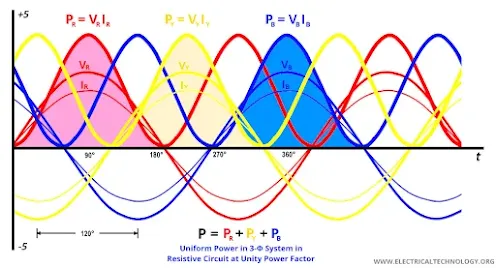Advantages of Three Phase System over Single Phase System
Currently, the three-phase AC system is widely adopted and utilized globally for power generation, transmission, distribution, and electric motor operation.
Three phase system has the following advantages as compare to single phase system:
- The power-to-weight ratio of a three-phase alternator is higher compared to a single-phase alternator. This means that for generating the same amount of electric power, the three-phase alternator requires a smaller size, resulting in reduced overall cost. Additionally, the reduced weight makes transportation and installation more convenient, requiring less space in powerhouses.
- In electric power transmission and distribution systems, the three-phase system requires less conductor material compared to a single-phase system for transmitting and distributing the same amount of power. As a result, the three-phase transmission and distribution system is more economical than the single-phase system.
- Consider the power produced by single-phase and three-phase supplies at unity power factor. The waveform of power produced by single-phase supply at unity power factor is shown in figure (C), while figure (D) depicts the waveform of power produced by three-phase supply.
- The power waveforms depicted in figures (C) and (D) illustrate a notable distinction between the three-phase and single-phase systems. In the three-phase system, the instantaneous power remains nearly constant throughout the cycle, resulting in smooth and vibration-free operation of machines. Conversely, in the single-phase system, the instantaneous power pulsates and varies over the cycle, leading to vibrations in machines.
- Furthermore, the power-to-weight ratio of a three-phase induction motor is higher compared to a single-phase induction motor. This means that for the same amount of mechanical power output, the size of the three-phase motor is smaller, resulting in reduced overall cost. Additionally, the reduced weight makes transportation and installation of the three-phase motor more convenient, requiring less space.
- A notable advantage of the three-phase induction motor is its self-starting capability. This is attributed to the rotating nature of the magnetic flux produced by the three-phase supply, which has a constant magnitude. In contrast, the magnetic flux produced by a single-phase supply in a single-phase induction motor is pulsating, making it non-self-starting. Therefore, additional arrangements are necessary to facilitate the self-starting of single-phase induction motors, thereby increasing their overall cost.
- 3-phase motor is having better power factor
- The power-to-weight ratio of a three-phase transformer is higher compared to a single-phase transformer. This means that for the same amount of electric power, the size of a three-phase transformer is smaller, resulting in reduced overall cost. Additionally, the reduced weight facilitates transportation and installation, requiring less space.
- In the event of a fault occurring in any winding of a three-phase transformer, the remaining two windings can be utilized in an open delta configuration to serve the three-phase load. This capability enhances the reliability of the three-phase transformer, which is not possible with a single-phase transformer.
- Furthermore, a three-phase system can be used to supply power to a single-phase load, whereas the reverse is not possible.
- The ripple factor of DC rectified from a three-phase supply is 4%, while the ripple factor of DC rectified from a single-phase supply is 48.2%. This means that DC rectified from a three-phase supply contains fewer ripples compared to DC rectified from a single-phase supply. Consequently, the requirement for filters in DC rectification from a three-phase supply is reduced, leading to a lower overall cost of the converter.
FAQs
1. What
are the advantages of a three-phase system over a single-phase system?
- A three-phase system offers higher
efficiency, smoother operation, and greater reliability compared to a
single-phase system.
2. How
does the power-to-weight ratio of three-phase equipment compare to single-phase
equipment?
- The power-to-weight ratio of three-phase
equipment, such as transformers and motors, is higher than that of single-phase
equipment. This means that three-phase equipment can deliver the same amount of
power with smaller size and weight.
3. What
benefits does a three-phase system offer in terms of overall cost and size
reduction?
- Due to its higher power-to-weight ratio, a
three-phase system results in reduced overall costs and smaller equipment sizes
compared to a single-phase system.
4. Can you
explain the reliability advantage of three-phase transformers over single-phase
transformers?
- In a three-phase transformer, if a fault
occurs in one winding, the remaining two windings can still be utilized to
serve the load, increasing overall system reliability. This redundancy is not
available in single-phase transformers.
5. What
flexibility does a three-phase system provide in terms of fault tolerance and
load balancing?
- Three-phase systems offer greater fault
tolerance and load balancing capabilities, as faults in one phase can be
compensated by the other phases, ensuring continuous power supply.
6. How
does a three-phase system enable efficient power delivery to both three-phase
and single-phase loads?
- Three-phase systems can efficiently
deliver power to both three-phase and single-phase loads, providing versatility
and flexibility in power distribution.
7. What is
the significance of lower ripple factor in DC rectification from a three-phase
supply?
- Lower ripple factor in DC rectification
from a three-phase supply results in smoother DC output, reducing the need for
additional filtering components and lowering overall costs.
8. How
does a three-phase system facilitate smoother operation and reduced vibrations
in machinery?
- The constant and balanced nature of
three-phase power supply leads to smoother operation and reduced vibrations in
machinery compared to the pulsating nature of single-phase power.
9. What
advantages does a three-phase induction motor offer in terms of self-starting
capability and performance?
- Three-phase induction motors have
self-starting capability due to the rotating magnetic field produced by the
three-phase power supply, resulting in reliable and efficient motor
performance.
10. Can
you elaborate on the space-saving benefits of three-phase equipment in
transportation and installation?
- The smaller size and weight of
three-phase equipment make transportation and installation more convenient,
requiring less space and reducing logistical challenges compared to
single-phase equipment.



0 Comments